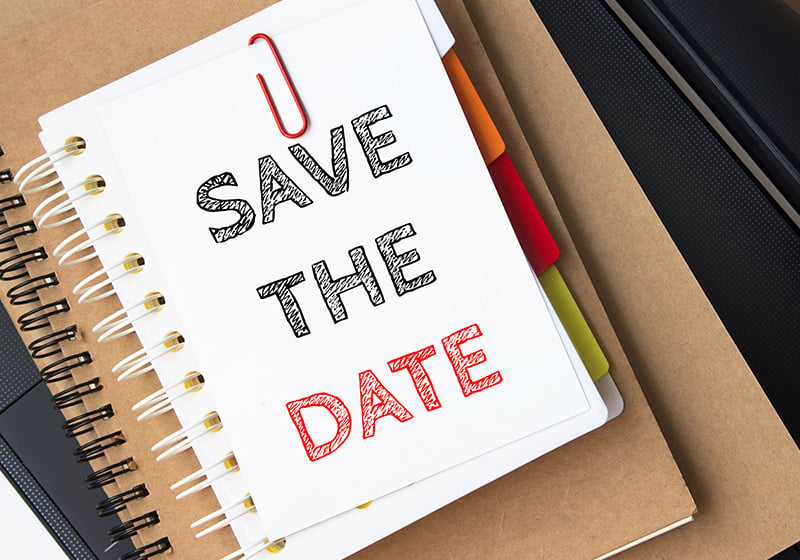Table of Contents
Among the vast array of linguistic expressions in the English language, few have gained as much ground and resonance as “SAVE THE DATE.” This phrase, originally coined to formally announce a future event and invite people to mark the date on their calendars, has undergone a remarkable evolution. Today, “SAVE THE DATE” has embraced a variety of nuanced meanings and has surpassed its initial usage, becoming an indispensable part of our everyday language. In this article, we will carefully explore the numerous variations and multiple applications of “SAVE THE DATE,” showing how this seemingly simple expression has become a versatile linguistic resource that transcends various cultural and social contexts.
We will trace the use of the expression “SAVE THE DATE”, including its evolution over time and its significance in a diversified range of contexts. Its ubiquity today makes it a crucial element in communication and event organization, from the personal to the professional sphere.
Why Has “Save the Date” Become Trendy?
In recent years, the use of “SAVE THE DATE” has become increasingly popular for several reasons. Firstly, we live in an era where instant and digital communication is the norm, and “SAVE THE DATE” aligns perfectly with this trend. You can easily send a “SAVE THE DATE” message via email, SMS, or social media, quickly reaching a wide audience.
Furthermore, “SAVE THE DATE” adds an element of anticipation and excitement to events. When you receive a “SAVE THE DATE” for a wedding, a party, or a special event, it’s like getting a small taste of what’s to come. It allows you to mark the date on your calendar and start planning ahead, creating a sense of anticipation that heightens enthusiasm.
The flexibility of “SAVE THE DATE” is another reason for its growing popularity. It can be used in a wide range of contexts, from personal to professional, making it a versatile communication tool. This versatility makes it suitable for many different situations, contributing to its widespread use.
Lastly, “SAVE THE DATE” adds a touch of class and sophistication to events. Using it in invitations, especially for weddings or corporate events, conveys a sense of formality and commitment, highlighting the significance of the occasion.
In conclusion, “SAVE THE DATE” has become trendy because it aligns perfectly with the digital age, creates excitement and anticipation, offers flexibility, and adds an element of elegance to invitations. This expression is destined to remain a key element in our daily communication and future event organization.
Usage Contexts for “SAVE THE DATE”:
1. “SAVE THE DATE” for Wedding Invitations:
One of the earliest and most common variations of “SAVE THE DATE” pertains to wedding invitations. When a couple decides to get married, they often send “SAVE THE DATE” notices to their loved ones and friends to announce the wedding date in advance. This is a helpful practice to ensure that people have enough time to plan and attend the celebration.
2. “SAVE THE DATE” for Special Events:
In addition to weddings, “SAVE THE DATE” is used to announce special events such as birthday parties, graduations, baptisms, and baby showers. It is an effective way to inform people in advance about the event and ensure a large turnout.
3. “SAVE THE DATE” for Conferences and Seminars:
In the world of business and education, “SAVE THE DATE” is used to promote conferences, seminars, workshops, and other professional events. Organizers send emails or post announcements on social media to invite the audience to save the event date.
4. “SAVE THE DATE” for Romantic Dates:
The use of “SAVE THE DATE” has also extended to romantic dates. Couples can use this expression when they want to plan a special evening together or a romantic surprise. It’s a cute way to keep your partner in suspense and create anticipation.
5. “SAVE THE DATE” for Reservations:
In the travel and hospitality industry, “SAVE THE DATE” is often used to make reservations for hotels, restaurants, or other services in advance. This ensures that customers have a reserved spot or an available room on their desired date.
6. “SAVE THE DATE” in Work Messages:
In a professional context, “SAVE THE DATE” is used to announce meetings, corporate events, or important deadlines. This helps colleagues plan their activities accordingly.
7. “SAVE THE DATE” on Social Media:
Social media has amplified the use of “SAVE THE DATE.” People share event announcements, travel plans, and even special moments in their lives through posts, stories, and virtual invitations.
8. “SAVE THE DATE” in Personal Organization:
Finally, “SAVE THE DATE” can be used in everyday life to remind oneself of important appointments, deadlines, or tasks. It’s an effective way to keep a well-organized calendar.
Conclusion:
“SAVE THE DATE” is a versatile phrase that has spread into many aspects of our daily lives. From sending wedding invitations to organizing special events, this expression has proven to be a useful tool for effectively communicating important dates. Regardless of the context, “SAVE THE DATE” is a simple and useful way to ensure that no one forgets a special event or appointment. So, remember to “SAVE THE DATE” for your future occasions!

